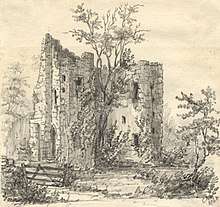Gidleigh Castle
Gidleigh Castle in the small village of Gidleigh on the south-eastern edge of Dartmoor, about 2 miles (3 km) north-west of the town of Chagford, Devon[1] was the manor house of the manor of Gidleigh .


It was built by William de Prouz in about 1324. It is now believed to have been a fortified manor house rather than a true castle, but the appelation of castle is by long tradition, for example it was called "Gidlegh Castell" by the Devon historian Sir William Pole (d.1635).[2] All that survives today is a small ruined keep tower with two storeys, an undercroft and a first floor hall. The ruins are grade I listed. [3]
Descent
Prouse
During the reign of King Henry II (1154-1189) the manor of Gidleigh was held by Walter Prous[5] (otherwise Prouz,[6] Prouse, le Prouz,[7] etc., Latinized as Probus,[8] meaning "upright, honourable"[9]). It was believed by Ralph Brooke (1553–1625), York Herald,[10] and by others, that his ancestor Peter Prouse of "Eastervale" married Mary de Vernon, daughter of William de Redvers, 5th Earl of Devon (died 1217),[11] feudal baron of Plympton, Devon, and widow of Robert de Courtenay (died 1242), of Okehampton Castle, Devon, feudal baron of Okehampton, son of Reginald de Courtenay (died 1194) by his wife Hawise de Curcy (died 1219), heiress of Okehampton. From this marriage the Courtenays later inherited the barony of Plympton in 1293 and in 1335 were declared Earls of Devon.[12] However Pole was sceptical of this high-status connection "which I can hardly admit without better proof than their allegation". He accepted that Mary de Vernon may well have been married to a man whose name was Latinized as Peter de Pratellis ("from the meadow"), better known by his Norman-French name Peter de Preaux, but had never seen the surname of Prouse Latinized in such a form, only as Probus. There is however one clear Courtenay connection: the building style and methodology used at the castles of Gidleigh and Okehampton, 6 miles to the north-west, are similar. The sandy magnesium limestone used in both buildings came from the same quarry and the same mason probably built both.
The last male of the Prous family was Sir William Prouz, who died during the reign of King Edward II (1307-1327). He married either Alis Reigny (according to Pole and GEC Complete Peerage) or Alis Widworthy (according to Risdon and Westcote). Alis Reigny was a daughter and co-heiress of Sir William Reigny of "Assholt"; Alice Widworthy was the daughter and heiress of Sir Hugh Widworthy of Lustleigh.[13] By whichever wife Sir William Prouz had a daughter and heiress Alis Prouse (1286-1335[14]), who married Roger Mules[15] (d.1323[16]) after his marriage seated at Lustleigh.
Sir William le Prouz ordered in his will to be buried amongst his ancestors at Lustleigh, but was in fact buried at Holberton. When his daughter Alice became aware of this error, she obtained permission from John de Grandisson (died 1369), Bishop of Exeter (1327-1369), to exhume the body and re-bury it at Lustleigh. The transcript of the episcopal licence is recorded by Risdon, in which she is named as nobilis mulieris domine Alicie Mules ("the noble woman Lady Alice Mules").[17]
Roger Moels of Lustleigh (d.1323)

It is believed[20] that the second son of Roger de Moels (c.1233/7-1294), feudal baron of North Cadbury in Somerset (and thus a brother of John de Moels, 1st Baron Moels (d. 1310)), was a certain Sir[21] Roger de Moels (d.1323[22]) of Lustleigh in Devon, called a "King's Yeoman" in 1301, who married Alice le Prouz, (1286-1335[23]), daughter and heiress of Sir William le Prouz of Gidleigh Castle.[24] and of Lustleigh, by his wife Alice de Reyny.[25]
Alice Prouse survived her first husband Roger de Moels and remarried to Sir John Damerell; Roger de Moels (d.1323) of Lustleigh is known to have had a son William de Moels (fl.1318), possibly by an earlier wife.[26]
References
- grid reference SX671884
- Pole, p.245
- Historic England. "Gidleigh Castle (1308353)". National Heritage List for England. Retrieved 10 July 2015.
- Vivian, p.626; Pole, p.497
- Pole, Sir William (d.1635), Collections Towards a Description of the County of Devon, Sir John-William de la Pole (ed.), London, 1791, p.245
- Vivian, Lt.Col. J.L., (Ed.) The Visitations of the County of Devon: Comprising the Heralds' Visitations of 1531, 1564 & 1620, Exeter, 1895, p.626-7, pedigree of Prouse
- GEC, p.5, note (c)
- Pole, p.246
- Cassell's Latin Dictionary, Marchant, J.R.V, & Charles, Joseph F., (Eds.), Revised Edition, 1928
- Pole, p.245
- Vivian, p.626, relying on Westcote
- Sanders, pp.70,138
- Risdon, p.133; Vivian, p.626
- GEC, p.5, note (c)
- Pole, p.245
- GEC, p.5, note (c)
- Risdon, pp.125-6
- Vivian, p.626; Pole, p.497; here repained incorrectly as or
- Vivian, pp.172-3
- GEC, p.5, note (c)
- Risdon, p.133
- GEC Complete peerage, p.5, note (c)
- GEC, p.5, note (c)
- Vivian, Lt.Col. J.L., (Ed.) The Visitations of the County of Devon: Comprising the Heralds' Visitations of 1531, 1564 & 1620, Exeter, 1895, p.626, pedigree of "Prouse of Chagford"
- GEC Complete Peerage, Vol.IX, p.5, note (c)
- GEC Complete Peerage, Vol.IX, p.5, note (c)
- Gidleigh Castle 1
- Fry, Plantagenet Somerset, The David & Charles Book of Castles, David & Charles, 1980. ISBN 0-7153-7976-3